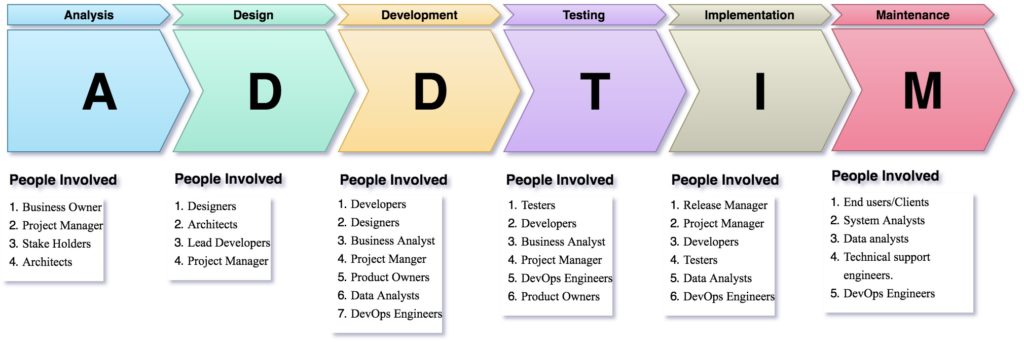SDLC can be defined as the combination of various stages that are needed to build a software application effectively by considering mainly quality and time constraints. This can also be referred to as Systems Development Life Cycle or Application Development Life Cycle. SDLC can be implemented by following different methodologies like Agile, Waterfall, etc.
Stages involved in SDLC

Analysis
This is one of the important stages of SDLC process. In this stage, Customers/Clients will meet the project team and state their expectations (in short) as to who would use the product and how they would need it. Here, Business owner along with Project Manager and Architects gather requirements for implementation of the project that would help reach customers’ expectations and record the results of their analysis in the requirements document which would serve as a guideline for the project team. This is the phase where project management will also decide the software development methodology (e.g. Agile, Waterfall etc.) and based on the decided methodology next phase in SDLC will take place.
Design
This phase can also be defined as transformation phase where an idea gets transformed into a working system. In this phase, Design team will work with Architects and lead developers to create high-level architecture for the software based on the approved functional and Non-functional requirements of the organization. Also design document will be created to be used in the next phases to be able to deliver all the elements like database design, Infrastructure design, Integration/Endpoint designs.
Development
Actual work begins in this phase which involves development of software as per the design and it is also considered as longest phase in SDLC. Developers come into picture and they convert the program specifications that are defined in the design document into computer instructions. There are two main elements that are needed to be considered to successfully achieve the software development which are “Complete set of design specifications” and “Proper processes, standards and tools”. Architects provide coding guidelines for developers to follow during the development. Depending on the methodology defined in the analysis phase, development teams work in time-boxed sprints(Agile) or single block of effort(Waterfall) to produce the working software effectively.
Testing
Test Engineers investigate and discover the product failures in this phase and also testing methods are defined here. Before companies release their product to end users, it is mandatory to test and rectify if there are any failures in the system. If any bugs found during this phase would be addressed by development teams followed by testing. Testing could either be a manual or an automation process and it depends on the requirements defined by the management. Several testing levels like integration testing, performance testing, acceptance testing are done here as per STLC. Once test engineers confirm that the system is error-free, it passes onto the implementation stage.
“Software testers succeed where others fail.” – Anonymous
Implementation
This is the phase where the developed product is deployed to its target environment and the operations are enabled. Also training to the end users on how to use the system is an another important action here. In this phase, project team ensures the security of end-product by certifying and accrediting it to use in production environment which is available to customers. After this phase, installed system enters the maintenance phase for the remainder of the system’s operational life.
Maintenance
In this phase, project team creates a help desk to support the end users if they have any concerns during product usage and try to address these issues as quickly as possible to ensure customer satisfaction. This involves fixing issues on the existing system, making additional changes to improve system’s performance, monitoring the performance of the system during and after the improvements.

